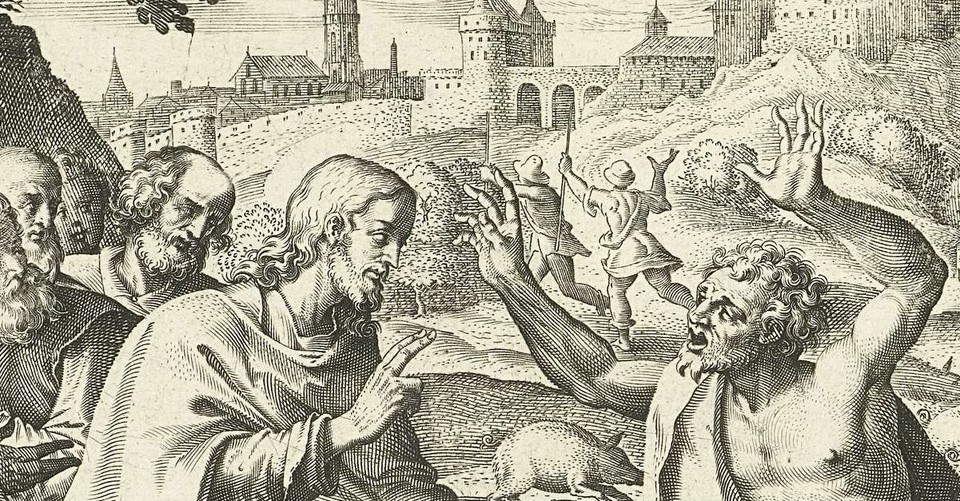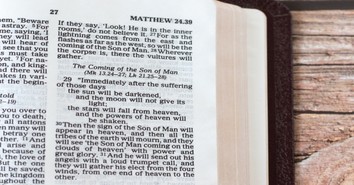What Do We Know about the Legion of Demons that Jesus Met?

It sounds like something from an epic fantasy novel: a horde of demons that calls itself a “legion.”
The gospels clearly show how Jesus regularly delivers people from demons. As a sign of his divine nature and ultimate authority, Christ has power over sickness, the weather, sin, and demonic activity, and the apostles share stories declaring these truths. Just as Joshua and David had to remove enemies and giants from the land to establish a kingdom, Jesus did the same spiritually for God’s Kingdom.
Specifically, when Jesus encounters a demon-possessed man, he learns the evil spirit’s name. “Legion.” Since Jesus is our teacher and model, what can we learn here?
Where Does the Bible Mention the Legion of Demons?
Mark 5:1-20 and Luke 9:26-39 record the story about the demon Legion, in which Jesus encounters a man possessed by numerous demons in the Gerasene region. Mark 5:9 details the interaction: “Then Jesus asked him, ‘What is your name?’ ‘My name is Legion,’ he replied, ‘for we are many.’” The demons declare that the man is possessed by many demons, emphasizing their overwhelming presence within him.
In Roman times, a legion was a large Roman army unit, typically composed of 3,000 to 6,000 soldiers. The term implied not just a large number but also an organized and formidable force. Roman legions stood as a fearsome force in the ancient world, renowned for their discipline, organization, and battlefield prowess. Soldiers, meticulously trained and well-equipped, these formidable units’ backbone. Each legionnaire carried a gladius, a short sword perfect for close combat, and a scutum, a large rectangular shield that provided superior protection.
The legions utilized sophisticated tactics, often outmaneuvering and overwhelming their enemies. In the testudo or tortoise formation, soldiers would align their shields to form a nearly impenetrable barrier against arrows and other projectiles. Their relentless drills ensured these maneuvers were executed precisely, even under battle and chaos. Roman commanders, such as Julius Caesar, showcased the strategic genius that made the legions so effective. They employed intricate battle plans, adapting swiftly to changing circumstances. Combined with their rigorous discipline, adaptability allowed the legions to conquer vast territories and subdue numerous adversaries.
Watching a Roman legion march into battle struck terror into people’s hearts. Their imposing presence and the thunderous sound of synchronized footsteps heralded inevitable defeat for those who dared to stand against them. Therefore, the Roman legions proved their legacy among history's most fearsome military forces.
For the demon to use this name, it likely wanted to instill fear and intimidation. Of course, that didn’t work against Jesus.
Do We Know for Sure If it Was Really a Legion of Demons?
Scripture doesn’t give a firm number for how many demons possessed the man. The demon only gives the name Legion because “we are many.” Using the name suggests a large number but not necessarily an exact figure. Scholarly debate continues whether “legion” refers to an exact number or signifies a multitude. Scholars argue regarding the term’s intended implication.
One perspective argues that Mark 5 used “legion” to convey the overwhelming and formidable demonic presence within the man rather than to specify an exact number. Generally, ancient texts used hyperbolic language to emphasize severity and intensity. The man’s condition, characterized by extraordinary strength and uncontrollable behavior, aligns with this interpretation.
Another scholarly viewpoint considers the term “legion” more literally. Some argue the reference might imply a specific, though large, demonic number. They point to the fact that approximately 2,000 pigs were involved in the incident (Mark 5:13), suggesting the number of demons could be in the thousands, potentially matching the Roman legion’s size. A smaller legion could be around 2,000.
A theological perspective focuses on the term’s symbolic significance. Symbolically, choosing the term “legion” emphasizes the demonic oppressive and destructive power over the man, contrasting sharply with Jesus’ authority and power to deliver and heal. Legions implied conquest, taking territory for an oppressive Roman Empire, along with a singular focus and organization. Legions trained to move as one force, connecting to how Jesus taught the kingdom of darkness couldn’t be divided against itself (Matthew 12:25).
How Does Jesus Respond to the Legion of Demons?
In Mark 5, Jesus responds to the legion of demons with authority and compassion, demonstrating his power over evil spirits and his care for the afflicted man.
Upon seeing Jesus from a distance, the possessed man runs to him and falls on his knees, shouting, “What do you want with me, Jesus, Son of the Most High God? In God’s name don’t torture me!” (Mark 5:7). The demons within the man recognized Jesus’ divine authority and feared his power. As James says, the demons believe in doctrinal truth and tremble (James 2:9). Even evil declares truth in the presence of God. The demons beg Jesus not to bring them torture, pleading for a less harsh fate.
Jesus demonstrates his authority by commanding the demons to identify themselves. Names have power, which the ancient world believed, whether their gods or others. Just as God gives names for himself, the angels had names (Gideon, Michael, etc.), and therefore, demons would also have names. The demons replied, “My name is Legion, for we are many” (Mark 5:9). Interestingly, the demon uses both singular and plural, even from the Greek, revealing the unity within these untold demonic thousands within one man.
Knowing Jesus could send them into hell and further torture, the demons then beg Jesus to allow them to enter a nearby herd of pigs instead. Jesus grants their request, saying, “Go!” (Matthew 8:32). The demons leave the man and enter the pigs, which then rush down a steep bank into the lake and drown, about two thousand in number (Mark 5:13). Old Testament law considered pigs to be unclean, which provides more spiritual symbolism, like the unclean animals were the perfect place for defiled spirits.
Jesus’ decisive act demonstrates his power to command and expel not just one but many demons with a single word. The immediate and man’s dramatic liberation reveals the comprehensive nature of Jesus’ deliverance.
And it scared people.
What Do Locals Do After Jesus Removes the Legion of Demons?
The locals immediately show fear. When the herders who witnessed the event see the possessed man healed and the pigs destroyed, they run off to tell the townspeople and the surrounding countryside what has happened. In Mark 5:14-15, it is written, “Those tending the pigs ran off and reported this in the town and countryside, and the people went out to see what had happened. When they came to Jesus, they saw the man who had been possessed by the legion of demons, sitting there, dressed and in his right mind, and they were afraid.”
Seeing the formerly possessed man sitting calmly, clothed, and sane, the locals are struck with fear at an unmistakable supernatural event. Looking at the man, who had previously been uncontrollable and tormented, now completely restored, shocks them and challenges their understanding of spiritual authority. While they likely wanted the demoniac “problem” dealt with, Jesus demonstrating his authority unsettled them.
Additionally, destroying the swine herd causes economic concern. Losing so much livestock represents a significant economic blow to the community, which adds to their unease about Jesus’ presence and actions. It’s ironic since Jewish people weren’t supposed to deal with unclean animals.
As a result, the locals plead with Jesus to leave their region. Mark 5:17 states, “Then the people began to plead with Jesus to leave their region.” Their request reflects their inability to fully grasp or accept the divine power they had just witnessed. However, they had just witnessed miraculous healing, abundant compassion, and power. Despite the miraculous healing, the disruption to their normalcy and the fear of further unknown consequences led them to prefer Jesus not stay among them.
Before leaving, the man wanted to leave with Jesus, but Christ instructed the healed man to stay and share his story. Mark 5:19-20 records, “Jesus did not let him [the healed man] come with him, but said, ‘Go home to your own people and tell them how much the Lord has done for you, and how he has had mercy on you.’ So the man went away and began to tell in the Decapolis how much Jesus had done for him. And all the people were amazed.” Jesus, in his love, didn’t allow the locals to dismiss or dodge the miracle they had just witnessed. The healed man’s testimony serves as a continuous witness to Jesus’ power and mercy, ensuring that even though Jesus leaves, the impact of his miracle remains. The man’s proclamation throughout the Decapolis (a region of ten cities) spreads the news of Jesus’ miraculous works, and the people are left amazed by his story.
What Can We Learn from the Story about the Legion of Demons?
We can learn several lessons from Jesus and the legion of demons.
First, the story underscores Jesus’ supreme authority over demonic forces. When he arrives, the demons fall in submission and declare his authority. We can take comfort knowing Jesus alone holds ultimate victory over all spiritual realms. The Lord’s assurance bolsters our faith and teaches us we can only overcome an overwhelming and unified spiritual enemy through Christ’s power.
Second, the narrative emphasizes Jesus’ compassion and willingness to deliver those in bondage. The possessed man’s condition was dire; he lived among the tombs, was uncontrollable, and experienced constant torment. Despite the man's seemingly hopeless situation, Jesus approaches and heals him. The deliverance showcases Jesus’ deep compassion and readiness to save. No one is beyond God’s reach, even the most hopeless ones. His love and mercy extend to the most desperate circumstances.
Third, we mustn’t react as the townspeople do, with unbelief. When Jesus moves among people, he changes and disrupts things. Most want change but not radical revolution. However, radical revolution is what comes with God. Knowing his Lordship, his power, and his love, we must realize his disruption in our lives will lead to good and life. Just as Jesus used the situation to remove unclean pigs from the town, he will do the same with us, sanctifying us to heal and protect us in love. We must embrace faith in Jesus’ authority and not allow fear or misunderstanding to dismiss or reject his presence.
Finally, the account highlights the power of personal testimony. After his deliverance, the healed man wants to follow Jesus, but Jesus instructs him to stay and bear witness. The man obeys, and his testimony spreads throughout the Decapolis, which amazes people (Mark 5:20). Sharing our personal and transformational experiences with Jesus has a great impact. Revelation 12:11 tells us overcomers do so by the blood of the Lamb and the word of our testimony, what God has done. We must encourage each other to tell stories of transformation to inspire faith and draw others to Christ.
Peace.
Photo Credit: Public domain image (print based on Maerten de Vos illustration)

This article is part of our People from the Bible Series featuring the most well-known historical names and figures from Scripture. We have compiled these articles to help you study those whom God chose to set before us as examples in His Word. May their lives and walks with God strengthen your faith and encourage your soul.
4 Things You May Not Know About Abraham in the Bible
20 Facts You May Not Know About Moses from the Bible
Who Was Mary Magdalene in the Bible?
Who Were the 12 Disciples of Jesus?
Who Was Isaiah & Why Was He Important?
Originally published August 05, 2024.





